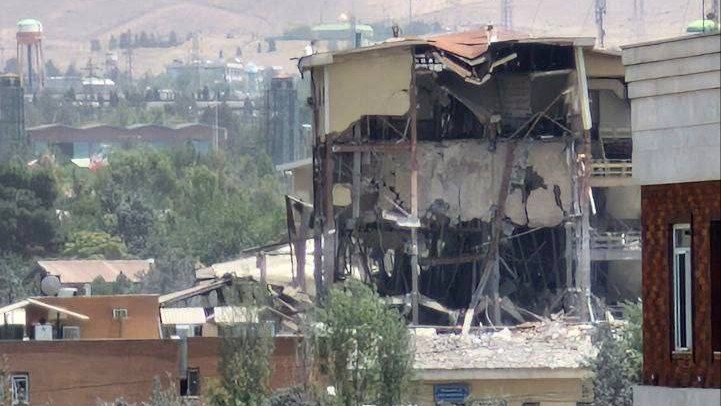Israel Defense Forces (IDF) launched a fresh wave of airstrikes on Tehran, hitting critical Islamic Revolutionary Guard Corps (IRGC) headquarters, including the Thar-Allah and Basij facilities. The IDF says Thar-Allah is tasked with “defending Tehran against security threats, including internal unrest,” while Basij enforces Iran’s strict Islamic code and monitors civilians. The strikes, part of a broader campaign, also targeted the Sayyid al-Shuhada Corps and Iran’s internal security forces’ intelligence unit, aiming to disrupt regime stability. With reports of significant IRGC casualties, Israel’s move signals a bold escalation in its conflict with Iran.

Why These Strikes Matter
The IRGC is Iran’s most powerful military and political force, often called the backbone of the regime. Hitting its headquarters in Tehran—a city of 9 million—sends a clear message: no target is off-limits. The IDF’s focus on Thar-Allah, which secures the capital, and Basij, known for suppressing protests like those in 2022 over Mahsa Amini’s death, shows Israel aiming at the regime’s ability to control dissent. Social media posts on X buzz with clips of explosions lighting up Tehran’s skyline, with some users calling it “a surgical hit on Iran’s nerve center.” Others worry about civilian fallout in a densely packed city.
I once visited a Middle Eastern city during a tense political moment, and the heavy presence of security forces was chilling. Seeing videos of Tehran’s night sky ablaze reminds me of that unease—when power structures are shaken, the ripple effects hit everyone. This strike isn’t just military; it’s a psychological blow to Iran’s leadership.
What the IDF Hit and Why
The IDF detailed its targets:
- Thar-Allah Headquarters: Central to Tehran’s defense, it coordinates IRGC operations to counter internal and external threats.
- Basij Headquarters: This paramilitary group polices Iran’s streets, cracking down on dissent and enforcing cultural norms.
- Sayyid al-Shuhada Corps: Focused on homeland defense, it suppresses protests and unrest in Tehran.
- Internal Security Intelligence Unit: Monitors Iran’s own security forces, ensuring loyalty and controlling communications.
The IDF also struck Evin Prison, notorious for holding political prisoners, and a symbolic “Destruction of Israel” clock in Tehran, per reports. These hits aim to weaken Iran’s military and governance capabilities. A June 23 post on X claimed “Tehran’s burning,” with unverified footage showing fires near Basij HQ, hinting at the strikes’ intensity.
Iran’s Response and Civilian Impact
Iran’s state media confirmed damage to military sites, with Tasnim reporting a “large explosion” in western Tehran’s Kermanshah area. Iran launched retaliatory missile barrages, with 86 Israelis wounded and temporary power outages in southern Israel after a hit near a “strategic infrastructure facility.” In Tehran, residents face chaos—posts on X describe heavy traffic as people flee, though Iranian officials blame “poor auto maintenance.” The human toll is steep: Iran’s health ministry reported 224 deaths, mostly civilians, from recent strikes, while Israel counts 14 dead from Iranian missiles.
Imagine living in Tehran, hearing sirens, and rushing to a shelter with your kids. A friend who lived through a conflict zone once told me the worst part is the waiting—not knowing if the next explosion is yours. That’s the reality for many Iranians now, caught between military targets and civilian life.
The Bigger Picture
This wave follows Israel’s June 13 strikes that killed top IRGC brass, including chief Hossein Salami and Palestinian Division head Saeed Izadi, linked to Hamas’ October 7, 2023, attack. Israel’s campaign, backed by Prime Minister Netanyahu’s vow to “exact a heavy price,” targets Iran’s nuclear and missile programs alongside its military leadership. The IDF claims it destroyed a third of Iran’s missile launchers and hit nuclear sites like Natanz and Fordo. Meanwhile, Iran’s Supreme Leader Khamenei, reportedly in a bunker, vows defiance, but allies like Hezbollah are staying out, signaling Tehran’s isolation.
Whats Next for Israel-Iran Tensions
- Escalation Risk: Iran’s missile barrages and Israel’s relentless strikes raise fears of a wider war. G7 leaders, meeting in Canada on June 22, urged de-escalation, but Netanyahu’s rhetoric suggests no pause.
- Civilian Safety: With Tehran’s internet blackouts and Israel’s shelter warnings, both sides’ civilians are on edge. Check travel advisories if you’re in the region.
- Diplomatic Moves: Oman and the EU push for talks, but Iran pulled out of June 15 nuclear negotiations, citing Israel’s attacks. Trump’s mixed signals—praising Israel but urging a deal—add uncertainty.
Tonight’s strikes mark a turning point. Israel’s targeting of IRGC hubs shows a strategy to cripple Iran’s power structure, but at what cost? As missiles fly, the world watches a region on the brink.
